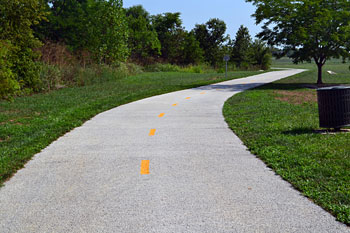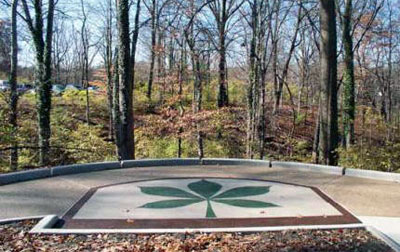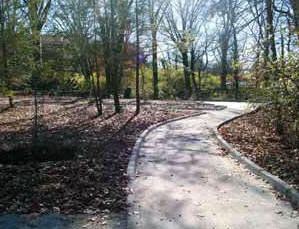Applications
Pervious Paths
Applications | Pervious Paths
 There's a good reason why so many of our nation's roadways are paved with concrete: it is the most durable, economical, and environmentally-friendly of all pavement options. Departments of Transportation and Municipalities choose concrete for its high performance and low life-cycle cost, and this is something to consider for paths as well, which can deliver especially well when constructed with pervious concrete.
There's a good reason why so many of our nation's roadways are paved with concrete: it is the most durable, economical, and environmentally-friendly of all pavement options. Departments of Transportation and Municipalities choose concrete for its high performance and low life-cycle cost, and this is something to consider for paths as well, which can deliver especially well when constructed with pervious concrete.
Pervious concrete has been a building material of choice in landscaping for heavily-used urban and garden paths, footpaths in country parks, rural trails and other recreation areas, and riverside paths. Its color is usually more sympathetic to rural settings than that of other materials such as Tarmac and asphalt, and it is especially ideal for sections of path which cannot be drained, or which are subject to stream/river erosion.
A Cincinnati producer's experience with pervious concrete was key in the successful placement of paths for an all-access city park...
Spurlino Materials: Cincinnati Producer’s Pervious Concrete Experience Keys Successful Placement for All-Access City Park
Article from the Winter 2008 Concrete InFocus Magazine
 For any civic construction project that aims to help the less fortunate, all the pieces have to fit. The goal in one Cincinnati neighborhood was to somehow enable a group of institutionalized city residents to use a nearby park that had long been enjoyed only at the fringes—wheelchairs obviously need hard surfaces, and they weren’t found at Hyde Park. Enter a group of city officials, advocates for those who would use the park, staff from the Ohio Ready Mixed Concrete Association and Spurlino Materials, an 8-year-old Middletown, Ohio-based ready mixed concrete producer and NRMCA member.
For any civic construction project that aims to help the less fortunate, all the pieces have to fit. The goal in one Cincinnati neighborhood was to somehow enable a group of institutionalized city residents to use a nearby park that had long been enjoyed only at the fringes—wheelchairs obviously need hard surfaces, and they weren’t found at Hyde Park. Enter a group of city officials, advocates for those who would use the park, staff from the Ohio Ready Mixed Concrete Association and Spurlino Materials, an 8-year-old Middletown, Ohio-based ready mixed concrete producer and NRMCA member.
For background, the city of Cincinnati has more than 100 public parks and other green spaces available for its 310,000 residents and 2 million metropolitan population. One park, the Bettman Nature Preserve adjacent to Hyde Park, now has a new system of concrete paths that are innovative in their safety design and have decorative aspects incorporated into their viewing platform destinations.
The nature preserve is a six-acre property located in the Evanston community, one of Cincinnati’s eastside neighborhoods. The “all persons” path project was first conceived when Jim Farfsing, the lead naturalist working at the Bettman Natural Resource Center, located within the preserve, noticed that residents of the nearby Beechwood Home for the Incurables gravitated to this park facility, but also saw that the facility did not offer universal accessibility.
To provide the park with paths that are accessible to all persons, Farfsing met with a city park engineer, Lisa Schafer, and a resident of Beechwood Home to form a preliminary alignment, a budget and a marketing piece for fundraising. The project was then adopted by the Cincinnati Parks Foundation and was led by both Cincinnati Parks’ staff and foundation staff.
This 4,120-square-foot area was constructed using eight inches of pervious concrete paved over a 12-inch base of clean No. 57 gravel.
Working with the director and staff of the Beechwood Home and potential donors, a design approach was developed along with a final budget. Willie Carden, parks director, and Steve Schuckman, parks superintendent, identified funding partners, and by late 2006, more than $300,000 in private funding was raised and then matched by $50,000 from the Park Board.
A local landscape architect worked with park staff and the committee of donors to develop designs of plant materials and leaf-shaped interpretations that were added to the concrete surfaces in the overlook areas through a staining process. These simple but elegant design elements helped to tie the trail experience to the local environment. The concept of accessible planting beds and interpretive signage to make the trail route an even richer outdoor experience was developed.
Jim Spurlino, president of Spurlino Materials, said 300 yards of 4,000-psi pervious concrete were placed to create 6-footwide paths measuring some 1,318 feet, or about a quarter-mile (the width was set for wheelchair passage along the path). Spurlino’s longtime pervious subcontractors, Mike Prus and Matt Kroell of Prus Construction Co, worked closely with park personnel to refine the path alignments and to ensure accessibility guidelines were met through the sometimes-challenging terrain. The donors had requested a custom rolled curb detail be integrated into the pathways throughout the project to facilitate use by blind or wheelchair-bound individuals.
The project had dual benefits for his company, Spurlino said, noting the decision to play a role in helping the less fortunate and the public’s awareness that concrete can be an environmentally friendly material. “We looked at it as part of our civic duty to do it as economically as possible,” he said. “And we certainly see green construction being a much bigger focus. It’s certainly our intent to be aware of the latest information that can benefit our customers.”
 Despite its modest size, the Bettman Nature Preserve project was one of the highest-profile projects for the company, Spurlino added, and was helped by the public’s growing awareness of the benefits of green construction. At this project, the combination of the pervious paths and the impressive colored staining details at the overlooks cast Spurlino and Prus Construction in a most favorable light.
Despite its modest size, the Bettman Nature Preserve project was one of the highest-profile projects for the company, Spurlino added, and was helped by the public’s growing awareness of the benefits of green construction. At this project, the combination of the pervious paths and the impressive colored staining details at the overlooks cast Spurlino and Prus Construction in a most favorable light.
To accomplish the staining, Prus cut stencils for the leaves out of plywood, then lightly sandblasted the leaf motifs onto the concrete. Circular rings in the overlook areas suggest tree growth and were achieved by saw-cutting the concrete to a depth of 3/8 of an inch to contain the stain. Concrete stains were chosen from a selection of waterborne, extra-strength stains. The colors used in the park were seafoam green, fawn, terra cotta, dark adobe and bark brown. Prus found that they could enhance the rings by applying varying coats of stain to different rings to improve the overall effect while limiting the color palette. The stained area cured for three days before it was sealed using a clear acrylic sealer with 30% solid content. To maintain the stain, it will need to be resealed every two to three years.
As an added feature of the “all persons” path project, the preserve also now has Cincinnati’s first pervious concrete parking lot installation. The 4,120-square-foot area was constructed using eight inches of pervious concrete paved over a 12-inch base of clean No. 57 gravel. Spurlino designed the pervious concrete using a mix of portland cement, No. 8 coarse aggregate, water and admixtures. The total construction cost of the concrete parts of the project was $187,000.
Spurlino Materials at a Glance
Spurlino Materials operates eight plants that supply a wide range of concrete applications to the metropolitan markets of Indianapolis, Cincinnati, Dayton and Northern Kentucky. The company also operates four mobile concrete plants that have operated at construction sites across the United States.
The original version of this article first appeared in a publication distributed by the Ohio Ready Mixed Concrete Association. Much of the text and reporting, along with the accompanying pictures, were provided by Lisa Schafer of Cincinnati’s parks department.
Click here to learn more about the benefits of both pervious and conventional concrete paths.


